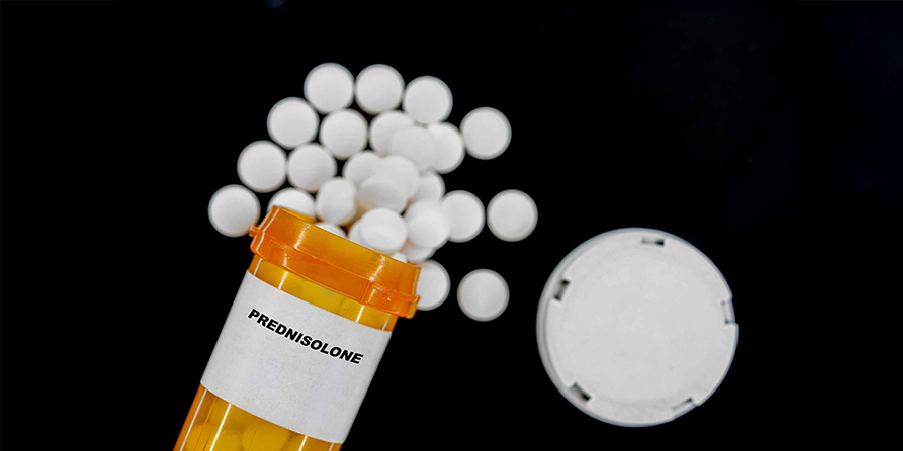Content on this page:
Content on this page:
Pharmacological therapy
Corticosteroid Hormones
Corticosteroid hormones are the most extensively
studied pharmacological agent in patients with severe alcoholic hepatitis.
Corticosteroid hormones may be considered in patients with a diagnosis of
severe alcoholic hepatitis with a Maddrey Discrimination Function (MDF) score
of ≥32, a Glasgow Alcoholic Hepatitis Score (GAHS)
of ≥9, or a Model of End-Stage Liver Disease (MELD)
score >20, and hepatic encephalopathy. Its action is to reduce the
pro-inflammatory response. Prednisolone is preferred over Prednisone as the
latter still needs conversion to the active form, Prednisolone, in the liver.
Corticosteroids are contraindicated in patients with uncontrolled upper GI
bleeding, acute kidney injury, acute pancreatitis, drug-induced liver injury,
hepatocellular carcinoma, uncontrolled infection, or multiorgan failure or
shock. N-acetylcysteine may be helpful in patients with severe alcoholic
hepatitis taking corticosteroids. The response to corticosteroid therapy is
assessed after 7 days utilizing the Lille score. If the patient is responsive
(Lille score <0.45), Prednisolone is continued for a total of 28 days. If
the patient is unresponsive (Lille score ≥0.45),
therapy is discontinued, and patient is evaluated for early liver transplantation.
Palliative therapy is considered in patients with alcoholic hepatitis who are
unresponsive to corticosteroid therapy, with multiple organ failures, and who
are not candidates for early liver transplantation.
 Alcohol-Related Liver Disease_Management 1
Alcohol-Related Liver Disease_Management 1Pentoxifylline
Pentoxifylline is an oral phosphodiesterase inhibitor that also inhibits the tumor necrosis factor (TNF) alpha production. In a study of patients with severe alcoholic hepatitis, Pentoxifylline, when compared with placebo, showed survival benefit related to a decrease in the incidence of hepatorenal syndrome. The action of Pentoxifylline may be related to the beneficial effects of the drug on microcirculation especially within the kidneys. However, further studies are required to confirm efficacy.
Points to consider before commencing treatment with Corticosteroids or Pentoxifylline
Before initiating treatment with Corticosteroids or Pentoxifylline, screening for HBV, HCV, and HIV is done. An abdominal ultrasound is obtained to rule out other etiologies of jaundice. Screening for infection in the blood, urine, and ascites culture is done along with a chest x-ray. Renal failure is screened in patients and hepatorenal syndrome is treated. Lastly, hyperglycemia must be controlled.
Granulocyte Colony Stimulating Factor (GCSF)
Recent data show improvement of liver disease, reduction in infectious complications, and patient survival with the use of GCSF. However, further studies are required prior to recommending its use for treatment.
Investigational Therapies
Colchicine, Propylthiouracil, S-adenosyl-L-methionine, and Silymarin have been studied in patients with ALD cirrhosis, but clinical endpoints did not show consistent benefits.
Colchicine
Clinical trials regarding Colchicine showed conflicting results. Further studies are required to confirm efficacy.
Propylthiouracil (PTU)
A recent meta-analysis found no significant effects of PTU vs placebo on mortality or liver-related mortality, complications of liver disease, or liver histology.
Antioxidants
Studies on Metadoxine have shown improvement in biochemical parameters, though additional studies are needed regarding its long-term effects. Regarding S-adenosyl-L-methionine (SAMe), reports suggest a decrease in mortality, but other trials have found no significant benefit. Lastly, Silymarin has been studied as a conservative treatment for ALD, but further trials are needed regarding its hepatoprotective effects.
Abstinence from Alcohol
Disulfiram, Naltrexone, and Acamprosate are approved abstinence and relapse prevention medications for patients with AUD. However, due to their potential for hepatotoxicity, Disulfiram and Naltrexone should be avoided in patients with ALD. Nalmefene is approved in Europe for the reduction of heavy drinking in AUD and may be considered when abstinence is not feasible in patients with early-stage liver disease. Baclofen is used in patients with moderate alcohol withdrawal symptoms and to prevent alcohol relapses in patients with advanced ALD. Benzodiazepines are used in patients with AUD for alcohol detoxification in order to treat withdrawal symptoms. Inpatient detoxification provides the safest setting for treatment of alcohol withdrawal due to the unpredictability of withdrawal symptoms. Patients are advised to refrain from the concurrent use of alcohol and benzodiazepines. Due to its potential for abuse and/or encephalopathy, benzodiazepines should not be given for >10 to 14 days.
Vaccination
It is recommended for patients to have immunization against hepatitis A and B, influenza, and pneumonia.
Other Treatment Measures
Lactulose and Rifaximin may be considered for the treatment of hepatic encephalopathy in patients with alcoholic hepatitis. Due to the potential risk of developing acute kidney injury in patients with severe alcoholic hepatitis, it is recommended to avoid diuretics and nephrotoxic drugs to prevent the development of renal failure. In patients with decompensated cirrhosis, stem-cell based therapies showed similar efficacy as standard of care while GCSF and Erythropoietin were shown to reduce 1-year mortality when compared to standard care.
Nonpharmacological
Abstinence from Alcohol
Abstinence
from alcohol is the cornerstone of long-term management of ALD. Though the safe
alcohol consumption level continues to be reviewed, patients with no liver
disease should be advised to take no more than 2 standard drinks per day for
males, and no more than 1 standard drink per day for females. Patients with ALD
or other liver diseases (eg MASH, MASLD, viral hepatitis, and hemochromatosis)
should be advised to completely abstain from alcohol.
Patients
are educated regarding the nature of the disease and the benefit of
discontinuing alcohol intake. Abstinence or marked reduction in alcohol intake
has been shown to improve histology and/or survival in all stages of ALD. Abstinence
can cause total resolution of alcoholic steatosis and improve long-term
prognosis in alcoholic patients. The risk of liver-related complications and
mortality is reduced following complete alcohol abstinence in patients with
alcohol-related cirrhosis.
Assistance
should be given to patients to help change their behavior. Psychosocial and
behavioral approaches may include counseling, group therapies, or inpatient
rehabilitation. Other modalities include cognitive behavioral therapy,
motivational interviewing or motivational enhancement therapy. Patients may
require consultation with a psychiatrist or addiction specialist.
 Alcohol-Related Liver Disease_Management 2
Alcohol-Related Liver Disease_Management 2Other Lifestyle Modifications
Smoking Cessation
It must be noted that smoking may increase the rate of progression of fibrosis in ALD. Hence, patients should be encouraged to stop smoking.
Obese Patients
Body mass index (BMI) has been shown to be an independent risk factor for ALD development. Physical activity and exercise are encouraged in obese patients.
Nutrition Therapy1
Most patients with alcoholic hepatitis suffer from some degree of malnutrition and should be considered for enteral nutrition and nutritional supplementation. The severity of malnutrition generally correlates with the severity of the liver disease. Protein calorie malnutrition is associated with high risk of cirrhosis complications (eg encephalopathy, ascites, infection). It must be noted that nutritional assessment should be on an ongoing basis and that long-term aggressive nutritional therapy is necessary.
Daily nutrition considerations:
- Emphasize multiple feedings including breakfast and nighttime snack to improve nitrogen balance
- Regular oral diet with increased dietary intakes (1.2-1.5 g/kg/day protein, 35-40 kcal/kg/day for energy)
- Salt restriction is advised for the treatment of ascites
- Vitamin and nutrient supplementation; fluid
replacement if deficient
- Vitamin B-complex supplementation is recommended due to the potential risk of Wernicke’s encephalopathy; may also consider therapeutic doses of zinc in patients with moderate and severe alcoholic hepatitis
The nutrition during acute illness or
exacerbation includes above-normal protein and energy which seem to improve
protein calorie malnutrition (1.5-2 g/kg/day protein, 40-45 kcal/kg/day for
energy). Enteral supplements may be used in those with severe disease or in
anorexic, hospitalized patients (conventional amino acid preparations may be
used). Patients with mild to moderate alcoholic hepatitis benefit from
abstinence and nutrition therapy and will likely not require nor gain from
medical treatment.
1Various nutritional products and supplements for
ALD are available. Please see the latest MIMS for specific formulations and
prescribing information.
Surgery
Liver Transplantation
Patients
with ALD or end-stage liver disease secondary to ALD cirrhosis (Child-Pugh C or
MELD-Na ≥21) may be considered for liver transplantation. Sick patients unable
to complete rehabilitation therapy may also be considered for liver
transplantation and can finish their rehabilitation therapy after surgery. Liver
transplantation may also be considered in select patients with severe alcoholic
hepatitis and favorable psychosocial profiles who are unresponsive to medical
treatment. The survival rate is comparable to patients who had transplantation
for nonalcoholic liver disease. Patients classified as Child-Pugh C and/or MELD
≥15 gain survival benefit.
Carefully evaluate the patient for the
following:
- Ability and commitment to abstain from alcohol
(eg abstinence from alcohol of a minimum of 6 months)
- The 6-month abstinence criterion alone should not be used as basis in patient selection as evidence to document its validity in predicting alcohol relapse is limited
- Damage to other organs (eg heart, brain)
- Malignancy in the upper GI tract or the upper airways
Immunosuppressive agents (eg Sirolimus or Everolimus)
should be used at the lowest effective dose for prevention of graft rejection.
Posttransplant patients are screened during each follow-up for use of alcohol
and other substances (eg cannabis, tobacco). Lastly, a transjugular
intrahepatic portosystemic shunt (TIPS) may be used to treat refractory ascites
secondary to cirrhosis and as a bridge to liver transplantation.
 Alcohol-Related Liver Disease_Management 3
Alcohol-Related Liver Disease_Management 3